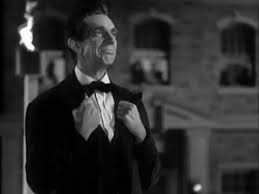
The great stentorian thespian Raymond Massey (1896-1983) turns out to be another distant relative of mine. Our mutual ancestors moved to Massachusetts in the 1630s. Massey’s forbears moved on to Ontario in the early 19th century. His great-grandfather Daniel Massey founded the Massey-Harris Tractor Company. To give you some idea of the family’s prominence north of the border, Raymond Massey’s brother Vincent was the first native-born Governor General of Canada.
Raymond Massey was initially expected to take part in the family business as an executive, and worked at it for a time, but following service in World War I and graduation from Oxford, he lobbied strongly to become an actor in spite of his family’s wishes. (He’d actually made his stage debut while on duty as a soldier in a camp show in Siberia).
Throughout the 1920s Massey acted in London’s West End, making the move to Broadway in 1930. From the beginning of the 1930s through the end of the ’50s, he split his time between stage and screen. He was highly prized for his excellent voice, but perhaps his most remarkable (and castable) feature was his intense, blazing eyes, which were perfect for fanatics and madmen, as well as hard-hearted villains, scowling patriarchs, or brooding, melancholy heroes.
He was Hamlet on Broadway in 1931 in an experimental production that couldn’t hope to live up to the shadow cast of John Barrymore (and in one of the worst years of the Depression, no less). In 1932, James Whale, whom he may known from the London stage, cast him in the campy horror-mystery classic The Old Dark House. In 1934 he directed and starred in The Shining Hour on Broadway, and played the villain in the Hollywood version of The Scarlet Pimpernel. Other high profile films of the period included H.G. Wells’ Things to Come (1936), and Fire Over England, Under the Red Robe, The Prisoner of Zenda, and John Ford’s The Hurricane (all 1937). In 1936 he also starred opposite Ruth Gordon on Broadway in Ethan Frome.

In 1938 Massey’s life, career and public image changed forever when he was cast as the title character in the original Broadway production of Robert Sherwood’s Abe Lincoln in Illinois. He reprised the role on film in 1940, with Ruth Gordon co-starring again as Mary Todd. As we wrote here, Massey was one of the best screen Lincolns.

That same year, he also became closely associated with another Civil War related role, that of the Abolitionist zealot John Brown in Santa Fe Trail. Those eyes! No one else could play him! Over the next several years, Massey would resurrect the roles of both Lincoln and Brown many times. He starred in two TV adaptations of Abe Lincoln in Illinois in 1950 and 1951. He played both Lincoln and Brown in the original Broadway production of Stephen Vincent Benet’s John Brown’s Body in 1953. He was Brown again in the film Seven Angry Men (1955) and Lincoln again on TV in The Day Lincoln Was Shot, and finally in the film How The West was Won (1962).
In the ’40s he appeared in various Shaw plays with Gertrude Lawrence and Katharine Cornell. In 1944 his only regrettable screen performance — as Jonathan Brewster in Frank Capra’s Arsenic and Old Lace. Massey is GREAT in it! It’s just that the part was devised for Boris Karloff, the script refers to Boris Karloff. Only Karloff should ever have played him. As fine as Massey is, if CGI could wipe him out and replace him with Karloff in the film, I’d be all for it. Other memorable roles and movies throughout the years: Possessed, opposite Joan Crawford (1947), Mourning Becomes Electra (1947), The Fountainhead (1949), East of Eden (1955), and McKenna’s Gold (1969).
Massey’s final Broadway role was in the original production of Archibald MacLeish’s J.B. (1958), directed by Elia Kazan. His last screen role was in a TV movie called My Darling Daughter’s Anniversary (1973), starring Robert Young.
His children Anna Massey and Daniel Massey were also successful actors.

You must be logged in to post a comment.